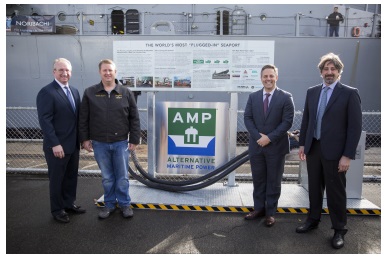Environment: Los Angeles, Vancouver (BC)
![]() Print this Article | Send to Colleague
Print this Article | Send to Colleague
Historic Battleship Iowa Plugs into 21st Century Technology at the Port of Los Angeles
Recognized internationally for pioneering the development and use of Alternative Maritime Power® (AMP®) for container ships, the Port of Los Angeles on January 23 unveiled a new permanent educational exhibit on the historic Battleship IOWA wharf.
Operated by the nonprofit Pacific Battleship Center, the Battleship IOWA opened July 7, 2012, as an interactive naval museum on the Los Angeles Waterfront.
The historic battleship, which served in combat during World War II and the Korean conflicts before its final decommissioning in 1990, is the latest vessel to plug into clean, electric shore-side power at the port. The ship’s operational systems previously ran on a diesel generator.
According to the port, ships account for about half of all port-related pollution in San Pedro Bay. Plugging a ship into AMP® for a 24-hour period, the port says, achieves the same air quality improvements as taking 33,000 cars off the road.
"The Port of Los Angeles made history as the birthplace of electric shore-side power technology for container ships," said Jonathan Williams, president and CEO of the Battleship IOWA museum. "So it’s fitting that a historical icon like the Battleship IOWA will house an exhibit where the public can learn about AMP®."
AMP® technology allows vessels to shut down their diesel engines while at berth and plug into clean shore-side power to run on-board systems. The port first used AMP® in 2004. That was three years before the California Air Resources Board began requiring container, cruise, and refrigerated cargo ships that routinely call at the state’s largest ports to use AMP® or an equivalent technology. International standards for shore-side power connections took effect in 2012.
"The port’s success with AMP® technology has only been possible with the support and cooperation of many, including Cavotec, our terminal operators, participating shipping lines and so many others in our port community," said Port Executive Director Gene Seroka. "We’re working with ports worldwide not only on AMP® technology, but also to continue exchanging data and testing other promising zero and near-zero technology that promotes more sustainable port operations and cargo movement."
The AMP® exhibit a joint project of the Battleship IOWA, Cavotec and Port of Los Angeles includes heavy-duty AMP® cables and connectors. It celebrates the technology’s success, its adoption at ports worldwide, and the stakeholders who helped make AMP® a viable alternative for container and cruise ships calling at the port.

Unveiling a new educational exhibit about shore-side Alternative Maritime Power technology at the Port of Los Angeles From left: Port Executive Director Gene Seroka, Battleship IOWA CEO Jonathan Williams, 15th District Councilmember Joe Buscaino, and Cavotec Ports & Marine Group Manager Luciano Corbett.
Photo/Port of Los Angeles
New Incentive for Cargo and Cruise Vessels Intended to Quiet Waters around the Port of Vancouver for At-Risk Whales
The Vancouver Fraser Port Authority has launched an incentive program for marine vessels operating in the Port of Vancouver aimed at addressing concerns about underwater vessel noise affecting at-risk marine life.
On January 1, the port authority added incentive criteria to its existing EcoAction* program to include harbor dues rate discounts for quieter ships.
Since 2007, the port authority’s EcoAction program has recognized a variety of fuel, technology and environmental management options that make ship operators eligible to receive discounted harbor dues rates. The new criteria include three quiet-vessel ship classifications and three propeller technologies shown to reduce underwater noise. The program applies only to cargo and cruise vessels calling on the Port of Vancouver, which includes Burrard Inlet, the Fraser River and Roberts Bank terminals.
The ECHO program aims to better understand and reduce the cumulative impacts of commercial vessel activities on at-risk whales throughout the southern coast of British Columbia. The program is a collaborative research initiative involving marine transportation industries, conservation and environmental groups, First Nations individuals, government and scientists.
The ECHO program commissioned a literature review and sought input from technical experts including naval architects, acoustic specialists and marine mammal researchers, to create the new criteria. The study team identified and evaluated various vessel-quieting designs, technology and maintenance options. Factors considered in the criteria identification and evaluation process included noise reduction effectiveness and ability to verify technologies and classifications. The port authority incorporated criteria developed from the study in the new incentives.
"Adding underwater noise reduction criteria to our EcoAction program is an exciting next step towards our long-term goal of reducing the impacts of shipping activities on at-risk whales," said Duncan Wilson, vice president of corporate social responsibility at the Vancouver Fraser Port Authority.

